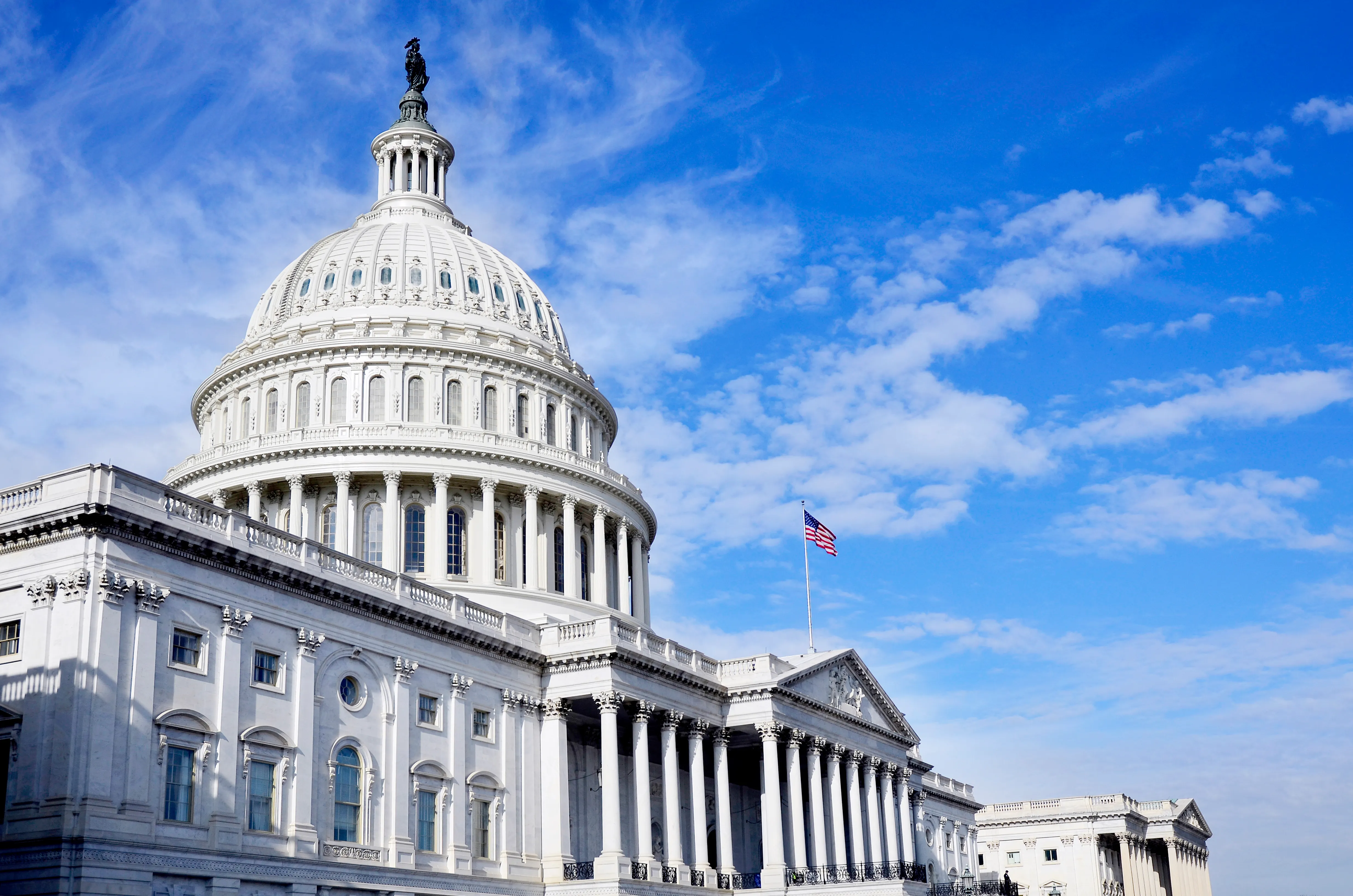On a recent Jefferies webinar, leaders from the firm’s Washington Policy & Sustainability, and Global Macro teams explored how U.S. policy and global macro trends are shaping investor behavior heading into the second half of the year.
The session featured Aniket Shah, Global Head of Washington Policy and Sustainability & Transition Strategy, in conversation with Mohit Kumar, Jefferies’ Chief Economist, and was moderated by William Beavington, Equity Specialist Sales, TMT.
Trump Advances the Platform He Ran On
Six months into the new administration, the policy environment is proving more predictable than many expected. U.S. Economic Policy Uncertainty (EPU) has dropped meaningfully since “Liberation Day,” when the administration sharply raised tariffs earlier this year.1 Monthly EPU peaked at 7.5% and has fallen to around 2%; daily EPU has dropped from over 9% to about 5%.
Part of that decline may reflect the perception that — whether or not one agrees with the agenda — President Trump is following through on what he campaigned on.
From immigration and trade to taxes and deregulation, the president’s policy platform aligns closely with his campaign promises. Border enforcement has tightened, with illegal crossings dropping from 250,000 per month under the prior administration to 25,000 in June.2 Tariff rates have risen sharply, from a weighted average of 2% to nearly 18%. The administration is also working to make Trump-era tax cuts permanent, with future offsets coming from cuts to Medicaid, clean energy programs, and EV incentives.3
One event investors are watching closely is the Fall 2025 Deregulation Agenda, due in October from the Office of Information and Regulatory Affairs.4 Federal agencies will be required to lay out how they plan to lower regulatory costs in line with the administration’s direction. Shah noted that while deregulation so far has mostly come through non-enforcement, this will be the first time agencies must formally detail how they intend to roll back rules — particularly in areas like energy and permitting.
A Strong Industrial Platform with a Focus on AI
A hands-on industrial policy has been a central feature of the president’s agenda.
Shah pointed to the Department of Defense’s recent public stake in MP Materials, a rare-earth mining company, as an early example.5 The company’s stock rose 20% on the news. More moves like this are likely, especially with a federal AI action plan expected soon. The administration is weighing $100 million in incentives to attract high-skilled software engineers from China, India, and South Korea, and is also looking to speed up permitting for power infrastructure to meet rising compute demand.
Shah tied these efforts to the broader goal of maintaining U.S. leadership in AI. The White House has floated a moratorium on state-level restrictions and is pushing for stronger federal control over AI regulation. The aim, he said, is to position the U.S. as a center of excellence — one with both the talent and infrastructure needed to stay ahead.
How Markets Are Responding to Recent Policy Moves
Kumar offered a readout on how markets are absorbing all this.
U.S. equities and credit are both near record highs, but he described the rally as driven more by positioning than by fundamentals. In April, investors were as underweight U.S. assets as they’ve been since the global financial crisis.6 As prices rose, they were forced to chase the market. Flows into passive funds accelerated the move, and enthusiasm around AI helped sustain it.
Still, he noted, the underlying picture has held up better than many expected. Recession fears have eased.7 Unemployment peaked at just 4.5%, well below levels typically associated with recession. Jefferies expects the S&P 500 to finish the year higher, and sees room for improvement in credit markets as well.
When Tariffs Might Start to Show Up in the Data
The effects of tariffs haven’t fully shown up in the data yet. Kumar said supply chain impacts tend to take about three months to register. That means July’s economic data, due in August, will offer the first clear read. There are other possible drag factors, too. If immigration and government hiring both slow, payroll growth could fall by 50,000 to 60,000 jobs per month. That could bring net new jobs close to zero.
At the same time, the administration’s new tariffs are expected to generate around $200 billion annually — roughly the cost of its new budget package, the OBBB.8 Shah noted that level of revenue will be politically difficult for future presidents to unwind. The current tariff regime, in other words, may be sticky.
The Fed’s Position Amid Expanding Executive Power
The Fed’s role also came up. The Supreme Court has recently expanded the president’s power over independent agencies, allowing more control over personnel and budgets. But it has drawn a clear line around the Fed, referring to it as a “quasi-private” institution, distinct from other agencies.9 10 Shah suggested that this distinction is aimed at maintaining international trust in the central bank.
There’s been speculation about whether Powell will be replaced. While Shah acknowledged that some “auditioning” is already happening behind the scenes, he and Kumar agreed that removing Powell could be more trouble than it’s worth. The Fed’s credibility remains key to maintaining dollar strength and market stability, particularly in Asia.
How U.S. Markets Compare to Global Alternatives
Looking abroad, Shah pointed to China’s upcoming 15th Five-Year Plan, due in October, as a key moment.11 It will lay out the country’s industrial priorities and likely reinforce the U.S.’s desire to respond with its own industrial policy. Southeast Asia may benefit in the short term, but Kumar sees the U.S. as the more attractive market over the next five years. Europe, he argued, faces demographic challenges, slower growth, and heavier regulation. Asia, while dynamic, is grappling with its own productivity constraints. Meanwhile, U.S. tech is still early in its AI cycle, and financials remain strong.
For investors, the second half of the year will bring several key signals: the deregulation agenda, AI policy, and China’s industrial roadmap. Much of the year’s direction has already been set — but how those plans take shape could determine what markets do next.
- https://www.csis.org/analysis/liberation-day-tariffs-explained ↩︎
- https://www.axios.com/2025/03/04/illegal-border-crossings-february-decline-trump ↩︎
- https://www.nbcnews.com/news/us-news/trump-big-beautiful-bill-tax-changes-rcna219853 ↩︎
- https://obamawhitehouse.archives.gov/omb/oira ↩︎
- https://www.ft.com/content/79b1693a-0788-4dc6-b431-027695534c62 ↩︎
- https://www.youtube.com/watch?v=kw9qp3XSzKM ↩︎
- https://www.wsj.com/economy/economists-us-recession-expectation-survey-91e45d95?gaa_at=eafs&gaa_n=ASWzDAgsTQfz65Dp1Kmri7I5bA8TUPUeUoDaxkgD-op-pfcbJFSzo24Nz5LUdfFMatM&gaa_ts=687fbd4a&gaa_sig=srxIxtcvmweB08GL8L8ktQOBGmSzOWuI7dIDWLNLhunGHCaeK2hnEBCUiTxm77p38n6XNkLvD_Yk6ZqN1XWxbw ↩︎
- https://www.whitehouse.gov/obbb/ ↩︎
- https://www.cshlaw.com/resources/u-s-supreme-court-authorizes-immediate-changes-at-independent-federal-agencies/ ↩︎
- https://www.supremecourt.gov/opinions/24pdf/24a966_1b8e.pdf ↩︎
- https://www.china-briefing.com/news/chinas-15th-five-year-plan-what-we-know-so-far/ ↩︎




